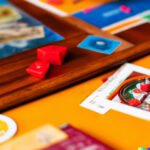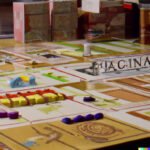Are you a fan of classic board games? Have you ever thought about creating your own versions at home? In this article, we will explore the world of DIY classic board games and all that it has to offer.
From the history of these timeless games to the benefits of playing them, we will take a comprehensive look at why they continue to be so popular. Whether you’re a seasoned DIY enthusiast or simply looking for a new hobby, there’s something for everyone in the world of DIY classic board games.
From ancient times to modern-day, classic board games have been a source of entertainment and social interaction. In this section, we will delve into the rich history of DIY classic board games and discover how they have evolved over time. We’ll explore their cultural significance and their enduring appeal, shedding light on why they have stood the test of time.
Additionally, we will discuss the many benefits of playing classic board games, from improving cognitive skills to fostering social connections. These timeless games offer a range of advantages for players of all ages. And by creating your own DIY versions, you can elevate these benefits even further through customization and personalization. So let’s embark on this journey together as we uncover the magic of DIY classic board games.
History of DIY Classic Board Games
The history of DIY classic board games is a fascinating journey that dates back to ancient times. Some of the earliest known board games can be traced back over 5,000 years to ancient Mesopotamia. These early games were often played on surfaces like stone or wood and used simple materials such as stones or sticks as game pieces. As civilizations evolved, so did board games, with new games being developed in different parts of the world.
One of the most iconic classic board games that has stood the test of time is chess. Its origins can be traced back to India during the Gupta Empire, around the 6th century AD. Over the centuries, chess spread throughout the world and underwent various changes and developments in different cultures. Similarly, other classic board games like backgammon, checkers, and dice games have enduring legacies that have transcended generations and geographical boundaries.
In modern times, classic board games continue to be an integral part of social gatherings and family activities. The advent of mass production has made these games more accessible, but there is also a growing trend towards creating DIY versions of classic board games. This allows for personalization and creativity while honoring the traditions and heritage associated with these timeless pastimes.
| Classic Board Game | Origin |
|---|---|
| Chess | India (6th century AD) |
| Backgammon | Mesopotamia (5000 years ago) |
| Checkers | Ancient Egypt (3000 BC)-> |
Benefits of Playing Classic Board Games
Playing classic board games offers a multitude of benefits that contribute to their enduring popularity. These games have been enjoyed for generations and continue to be an important part of social gatherings and family time. In this section, we will explore the various reasons why classic board games remain so beloved.
Enhancement of Critical Thinking and Problem-Solving Skills
Classic board games are known for requiring strategic thinking, planning, and problem-solving. Games like chess, Scrabble, and Risk challenge players to think several steps ahead, anticipate their opponent’s moves, and make calculated decisions. This helps sharpen the mind and enhance critical thinking skills in players of all ages.
Social Interaction and Bonding
One of the key factors contributing to the ongoing popularity of classic board games is their ability to bring people together. Whether it’s a family game night or a gathering with friends, playing these games encourages face-to-face interaction, communication, and bonding. A sense of camaraderie is fostered as players engage in friendly competition and share laughter and excitement throughout the game.
Reduction of Screen Time
In today’s digital age, many people spend a significant amount of time in front of screens. Classic board games offer a refreshing alternative by providing an opportunity to unplug from electronic devices and engage in an activity that is both entertaining and mentally stimulating. By participating in board game sessions, individuals can reduce their screen time while still enjoying themselves in an enriching way.
Materials and Tools Needed for DIY Classic Board Games
| Materials | Tools |
|---|---|
| Cardboard or game board material | Scissors |
| Game pieces or tokens | Ruler |
| Dice | X-Acto knife |
| Marker or paint for decoration | Glue or adhesive |
The materials needed for creating DIY classic board games are relatively easy to find and often just lying around the house. Cardboard or game board material can be repurposed from old boxes or purchased at a craft store. Game pieces, tokens, and dice can also be found at hobby shops, or you can get creative and make your own with everyday objects.
In terms of tools, basic supplies such as scissors, rulers, X-Acto knives, markers, and glue will be essential for crafting your homemade board games. These tools will help you measure and cut the materials with precision, as well as decorate and assemble the game components. With these materials and tools in hand, you’ll be ready to start creating your very own DIY classic board games.
Step-by-Step Instructions for Creating Your Own DIY Classic Board Games
Creating your own DIY classic board games can be a fun and rewarding experience. With a little creativity and some basic materials, you can bring your favorite games to life in a unique and personalized way. Whether you’re making a classic game like chess or putting your own twist on a game like Monopoly, here are some step-by-step instructions to help you get started.
First, gather all the necessary materials and tools for the game you want to create. This may include a sturdy board, game pieces, dice, cards, and any other specific components needed for the game. You can find these items at your local craft store or repurpose items from around your home to fit your needs.
Next, decide on the design and theme of your game. Are you creating a traditional version of the game or putting a modern spin on it? Consider the artwork, colors, and overall aesthetic of the game board and pieces. You can use stickers, markers, paint, or printouts to customize the look of your DIY classic board game.
Once you have all your materials and design ideas ready, start assembling the game board and pieces according to the rules of the classic game you are recreating. Use measurements and guidelines found online or in instructional books to ensure accuracy.
Don’t forget to test out the game as you go along to make sure everything works properly before adding any finishing touches. Creating your own DIY classic board game can be a labor of love but seeing it all come together will make it worth it in the end.
DIY Classic Board Game Ideas
When it comes to DIY classic board games, the possibilities are endless. Whether you’re a fan of strategy games like chess or prefer the thrill of real estate domination in Monopoly, there’s a game out there for everyone. Here are some popular DIY classic board game ideas that you can create and enjoy with friends and family:
- Chess: A game of skill and strategy, chess has been a favorite pastime for centuries. You can easily create your own chess set using simple materials like cardboard or wood, along with some basic crafting supplies.
- Monopoly: This iconic game of property trading and strategy can be recreated at home with a little creativity. You can design your own properties, money, and chance cards to personalize the game for endless hours of fun.
- Scrabble: For word enthusiasts, creating a DIY Scrabble game is a fantastic idea. Simply gather some wooden tiles, create letter designs or stickers, and arrange them on a handmade game board.
With these DIY classic board game ideas, you can bring the joy of these timeless games into your own home. Whether you’re looking for a challenging mental exercise or simply want to have fun with loved ones, creating your own classic board games can be a rewarding and entertaining endeavor.
Remember that the key to successfully making these games lies in attention to detail and personalization. Feel free to add unique touches or tailor the rules to suit your preferences – after all, it’s your game. So gather your materials and let your creativity run wild as you embark on the journey of DIY classic board game creation.
Tips and Tricks for Customizing Your DIY Classic Board Games
Customizing your DIY classic board games can add a personal touch and make the gaming experience even more special. Here are some tips and tricks for making your homemade board games one-of-a-kind:
- Choose a theme: Consider giving your classic board game a unique theme to add a creative twist. Whether it’s based on a favorite movie, book, or historical period, a themed board game can be exciting and visually appealing.
- Personalize the game pieces: Instead of using generic game pieces, personalize them to reflect your interests or hobbies. You can use small figurines, beads, or other trinkets that have significance to you and your fellow players.
- Create custom game cards: If your classic board game includes cards, consider making custom designs for them. Add illustrations, inside jokes, or personalized messages to make the game more entertaining.
In addition to these customization ideas, there are several tricks you can use to enhance the overall appearance and gameplay of your DIY classic board games:
- Upgrade the materials: Use high-quality materials such as durable cardstock for the game board and playing cards. This will ensure that your homemade board game lasts for years to come.
- Add storage compartments: Incorporate built-in storage compartments within the game’s design to keep all components organized and easily accessible.
- Test and adjust: Before finalizing your DIY classic board game, test it out with friends or family members. Take note of any imbalances or unclear instructions and make necessary adjustments for a smoother gameplay experience.
By following these tips and tricks, you can elevate your DIY classic board games from ordinary to extraordinary, creating memorable experiences for everyone involved in playing them.
Bringing People Together
Playing DIY classic board games not only brings enjoyment and nostalgia, but it also provides an opportunity for social interaction and connection with others. Whether it’s a family gathering, a game night with friends, or a team-building activity in the workplace, classic board games have the power to bring people together and create lasting memories.
Building Relationships and Bonding
One of the main benefits of playing DIY classic board games is the opportunity for building relationships and bonding with others. The shared experience of strategizing, competing, and having fun together can strengthen friendships, improve communication, and create a sense of camaraderie among players. It allows individuals to connect on a personal level, share laughs, and enjoy each other’s company in a meaningful way.
Promoting Teamwork and Collaboration
Classic board games often require teamwork and collaboration, fostering skills such as problem-solving, decision-making, and effective communication. Players must work together to achieve a common goal or overcome challenges within the game. This aspect of cooperation can translate into real-life scenarios where individuals are required to work as part of a team.
Fostering Friendly Competition
Playing DIY classic board games also encourages friendly competition among participants. While there is undoubtedly a desire to win, the competitive nature of these games promotes good sportsmanship and teaches players how to handle both victory and defeat gracefully. It creates an environment where individuals can challenge themselves and each other in a lighthearted and enjoyable manner.
In summary, the social aspect of playing DIY classic board games goes beyond just entertainment; it fosters meaningful connections, promotes teamwork and collaboration, and encourages friendly competition among participants. Whether it’s bringing families closer together or strengthening bonds between friends or colleagues, classic board games have the unique ability to create memorable experiences that will be cherished for years to come.
Conclusion
In conclusion, DIY classic board games offer a unique way to embrace nostalgia and have fun with friends and family. The history of these games dates back to ancient times, and they continue to be popular for good reason.
Not only do they provide entertainment, but they also offer numerous benefits such as improving cognitive skills, promoting social interaction, and fostering creativity. By creating your own DIY classic board games, you can personalize the experience and truly make it your own.
With the comprehensive guide on materials and tools needed, as well as step-by-step instructions provided in this article, anyone can try their hand at making their favorite classic board game from scratch. Whether it’s chess or monopoly, the possibilities are endless. The tips and tricks for customizing these games also allow for added creativity and personal touches, making each game unique.
Ultimately, playing DIY classic board games is not just about the game itself, but about bringing people together. The social aspect of gathering around a homemade game and enjoying each other’s company is truly invaluable. So why not embark on this journey of rediscovering the joy of classic board games by creating your own DIY versions? It’s a rewarding experience that brings together tradition, innovation, and most importantly, fun.
Frequently Asked Questions
How to Make an Original Board Game?
Making an original board game involves brainstorming a unique concept, designing the game board and pieces, creating clear rules and objectives, and playtesting to refine the gameplay. It’s important to explore different themes, mechanics, and strategies to ensure your board game stands out from others in the market.
What Are Some Board Game Ideas?
There are countless board game ideas that can be explored, ranging from strategy-based games like “Settlers of Catan” to cooperative games like “Pandemic.” Some ideas include creating a game based on a specific historical period or event, designing a fantasy-themed game with mythical creatures and quests, or even developing a trivia game focused on pop culture or science.
What Materials Can I Use to Make a Board Game?
When making a board game, there are various materials that can be used such as cardboard for the game board and player pieces, cardstock for cards, dice for randomization elements, and markers or tokens for keeping track of progress. Additionally, you may want to consider using craft supplies like colored paper, glue, scissors, and markers to add visual interest to the components of your game.
Ultimately, the materials chosen should align with the concept and theme of the board game being developed.

I love playing all kinds of games – from classics like Monopoly to modern favourites like Ticket to Ride.
I created this blog as a way to share my love of board games with others, and provide information on the latest releases and news in the industry.





